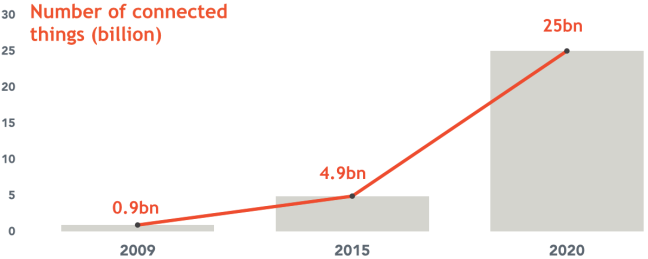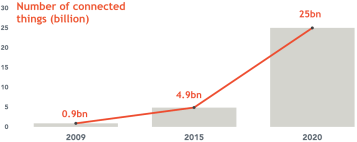The phrase, “the Internet of Things”, is believed to have been coined by a brand manager at Proctor and Gamble. Kevin Ashton, in a 1999 presentation, envisaged an exponential growth of connected devices, as supply chain logistics got smarter.
Today, the Internet of Things is seen as one of the most significant technology trends, with analysts predicting that the number of connected, smart devices will grow to tens of billions over the next few years.
Much of this proliferation will happen in the workplace. For Software Asset Managers, this could have significant implications. The Internet of Things will not merely be a corner case for SAM: it could impact some of the biggest contracts, with key vendors like Oracle.
Oracle’s licensing rules are explained, at some length, in their Software Investment Guide. One commonly-used license type is called “Named-User Plus”. Aimed at “environments where users and/or devices can be easily identified and counted”, the license model is illustrated with the following example:
Here, 15 fixed temperature devices are communicating directly with an Oracle database. There are also 30 forklifts, each of which has a transporter which also writes to the database.
In this case, a total of 415 licenses are required: 15 for the temperature sensors, and 400 for the humans operating the forklifts (because “the forklift is not a non-human-operated device”).
In the past, I’ve used this example, only semi-seriously, to illustrate what might happen if the Internet of Things grows at the speed of the pundits’ projections. Recently, the 2015 Gartner Predicts report for the Internet of Things projected an almost 28-fold growth in connected devices from 2009 to 2020.
The year 2009 is rather pertinent, because Oracle’s forklift example seems to have first appeared in the Software Investment Guide in that year (here’s an example at the Internet Archive).
If we crudely apply the Gartner’s connected growth rate to the number of devices shown in Oracle’s forklift example, there would be well over 1200 connected devices to license by 2020. That’s a trebling of the cost.
I have always laughingly acknowledged this as a crude illustration, until I chanced upon a March 2015 Forbes article titled “The Intelligent Forklift in the Age of the Industrial Internet of Things”:
Today’s “smart” forklift includes diagnostics that allow the equipment to signal when it needs to be serviced, speed controls, anti-slip technology that monitors wheel spin and improve traction on slick floors, collision detection, fork speed optimization, and more.
All of a sudden, my deliberately far-fetched example didn’t seem quite so unlikely.
As always, in Software Asset Management, the challenge is unlikely to be simple or contained. Software Asset Managers deal with many vendors, with many license types. Many of those licenses may depend on counts of connected devices. Many contracts pre-date the Internet of Things, which means costing models are outdated. Unfortunately, that’s unlikely to make the consumer any less liable.
In part 2 of this article, we will look at another major challenge already arising from the Internet of Things: the increasing application of software-style license terms to hardware.


